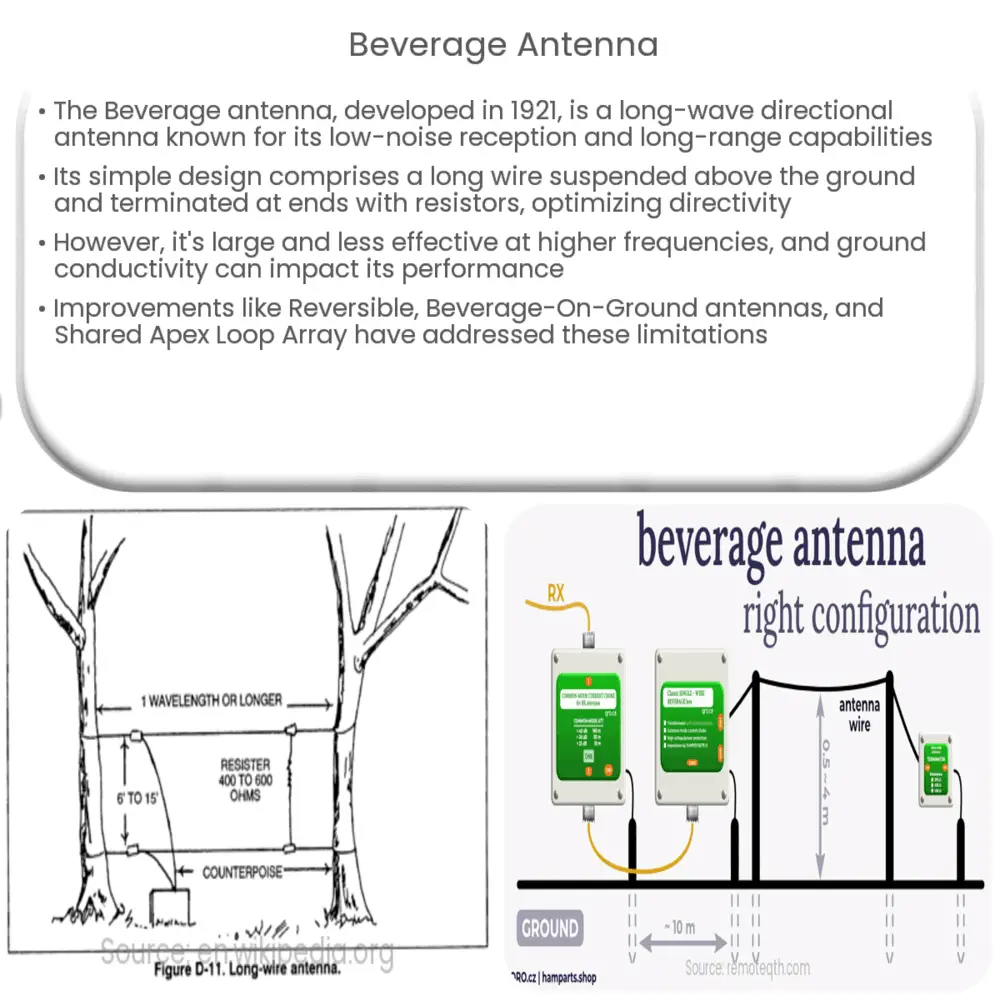The Beverage antenna is a long-wave, directional radio antenna known for low noise reception, long-range capabilities, and simple construction.

Beverage Antenna: A Classic Long-Wave Radio Receptor
Introduction
The Beverage antenna, named after its inventor Harold H. Beverage, has been a popular choice for radio enthusiasts and amateur operators since its development in the early 20th century. This long-wave directional antenna is especially effective for receiving low-frequency signals and is highly regarded for its simplicity, low noise reception, and ability to capture signals from great distances. In this article, we will explore the history, design, and working principles of the Beverage antenna, and discuss its applications and advantages in modern-day radio communication.
History of the Beverage Antenna
Harold H. Beverage, an American engineer, and radio pioneer, first developed the Beverage antenna in 1921 while working at the Radio Corporation of America (RCA). The invention came about as a result of Beverage’s efforts to improve the reception of transatlantic radio signals. The antenna quickly gained popularity for its excellent performance and was extensively employed during the early years of international broadcasting and point-to-point communication.
Design and Working Principles
The Beverage antenna is a simple, yet effective design consisting of a long wire, typically several wavelengths long, suspended above the ground and terminated at one or both ends with resistors. The wire is usually installed parallel to the ground, with a height of approximately 0.1 to 0.2 wavelengths. This configuration helps to minimize ground losses and achieve better directivity.
The principle behind the Beverage antenna’s operation is the traveling-wave effect. When a radio wave passes through the long wire, it induces a voltage along the length of the wire. Due to the antenna’s length and the resistive termination at one or both ends, the induced voltage travels along the wire as a wave, with its amplitude gradually decreasing. This traveling wave creates a directional pattern, with the antenna being most sensitive to signals arriving from the direction of the terminated end.
The Beverage antenna’s ability to receive low-noise signals is attributed to its low angle of radiation, which reduces the impact of locally-generated noise. Additionally, its resistive termination absorbs unwanted signals arriving from the opposite direction, further enhancing the antenna’s directional properties and signal-to-noise ratio.
Applications and Advantages
Although the Beverage antenna was initially designed for long-wave and medium-wave frequencies, it has found applications in various areas of radio communication. Some of its key advantages include:
- Low noise reception: Due to its low angle of radiation and resistive termination, the Beverage antenna is known for providing low-noise reception, making it ideal for weak signal detection and long-distance communication.
- Directionality: The traveling-wave effect allows the Beverage antenna to exhibit a directional pattern, which helps in capturing signals from specific directions and rejecting interference from other sources.
- Simple construction: The Beverage antenna’s simplistic design makes it easy to build and install, even for amateur radio operators with limited resources and technical knowledge.
Limitations and Disadvantages
Despite its many advantages, the Beverage antenna is not without its limitations and drawbacks:
- Large physical size: Due to its long-wavelength design, the Beverage antenna can be quite large, often spanning hundreds of meters in length. This may make it impractical for use in urban or space-limited environments.
- Poor performance at higher frequencies: The Beverage antenna’s effectiveness decreases as the operating frequency increases. Consequently, it may not be the best choice for short-wave and higher-frequency applications.
- Ground conductivity: The performance of a Beverage antenna can be significantly impacted by the conductivity of the ground beneath it. In areas with poor ground conductivity, the antenna’s efficiency may be compromised.
Improvements and Variations
Over the years, several improvements and variations of the Beverage antenna have been developed to address its limitations and enhance its performance. Some of these include:
- Reversible Beverage antenna: This design incorporates a switchable termination, allowing the antenna’s directionality to be reversed without physically reorienting it. This feature can be particularly useful in changing propagation conditions or for monitoring signals from different directions.
- Beverage-On-Ground (BOG) antenna: This variation lays the antenna wire directly on the ground or slightly elevated above it, providing a lower-profile option for situations where a traditional Beverage antenna installation is not feasible.
- Shared Apex Loop Array (SALA): The SALA is a compact, phased array of loop antennas that can mimic the performance of a Beverage antenna. It offers better performance in limited-space installations and can operate effectively on higher frequencies as well.
Conclusion
The Beverage antenna has remained a popular choice among radio enthusiasts and amateur operators for over a century due to its simplicity, low noise reception, and long-range capabilities. While it has its limitations, particularly in terms of size and performance at higher frequencies, various improvements and variations have been developed to overcome these challenges. For those interested in long-wave and medium-wave radio communication or weak signal detection, the Beverage antenna continues to be a valuable and time-tested tool.

